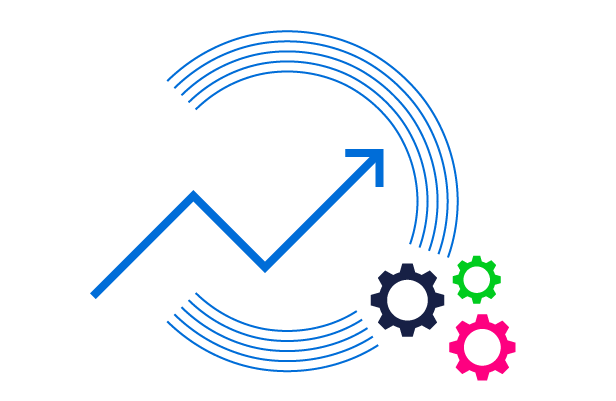Are you struggling to increase the conversion rate for your e-commerce sites ? You're not alone.
This eCommerce conversion rate optimization guide provides the strategies and actionable solutions you need to transform your online store into a sales-generating machine.
Let’s dive in!
What is the eCommerce Conversion Rate?
The eCommerce conversion rate is the percentage of visitors completing a desired action on a website. This action might be:
- Purchasing a product
- Subscribing to your newsletter
- Joining a waitlist
- Creating an account
- Following your Social Media accounts
- Adding products to a wishlist
- Adding products to the cart
These actions can turn an eCommerce website visitor into a customer, a lead, a prospect, or an opportunity.
For example, when a website visitor subscribes to your newsletter, they become a lead. When they make a purchase, they become a customer.
Why is the eCommerce Conversion Rate Important?
The eCommerce conversion rate is a critical metric for your business. It gives you insight into the effectiveness of your marketing campaign. Moreover, it helps you understand the order processing map of your eCommerce site and how your web design affects the customer experience.
Considering the conversion rate and other website metrics, you can make the appropriate adjustments and improvements to increase your eCommerce conversions, turning more users into customers!
How is the eCommerce Conversion Rate calculated?
To calculate your website’s eCommerce conversion rate, divide the number of web visitors who completed a desired action on your website (purchase, newsletter subscription, etc) by the number of total visitors. Then, multiply this number by 100, using the following formula:
E-commerce conversion rate = (Total visitors who completed a desired action / Total website visitors) x 100
For example, if you have 1,000 visitors and 30 conversions, your website’s conversion rate will be 3%.
What is the Average Conversion Rate for eCommerce Businesses?
The average eCommerce conversion rate is 2.5%-3%. However, the conversion rate of eCommerce stores depends on many factors and varies depending on the industry and the season.
Remember that even if you have a good eCommerce conversion rate, there's always room for improvement!
How Can You Measure Your Website’s eCommerce Conversion Rate?
You can use several tools to measure the conversion rate of your eCommerce store, including Google Analytics. Using this tool, you can understand the users’ behavior when they visit your eCommerce site.
This can help you identify UX/UI bottlenecks and resolve them, enhancing user experience and potentially increasing the conversion rate. It will also help you find where your conversion funnel has friction and reduce it.
Another channel you can use to understand your website visitors’ behavior is Social Media. Collecting data from your Social Media pages, including Instagram and Facebook, can help you identify and optimize the steps that lead to eCommerce conversions.
An effective Social Media strategy is essential for boosting conversions!
How Can you Increase your eCommerce Conversion Rate?
There are several ways to increase your e-commerce conversion rate. Let’s see the most effective eCommerce conversion rate optimization tactics!
#1 Improve your website’s user experience

Guest checkout option on IKEA's UK website
One of the most important steps you can take to increase eCommerce conversion rates is to improve user experience by making your website easier to navigate.
A well-designed website makes it easier for users to find what they’re looking for quickly and easily, increasing the chances of conversion. Additionally, you can optimize the checkout process and enable guest checkout, reducing the steps site visitors need to take to complete it!
#2 Reduce loading time
Websites that take too long to load tend to frustrate users, causing them to move to a different website. So, if your website’s loading time is long and your pages have high bounce rates, consider improving your website's speed.
According to a study by Deloitte, just by improving a website’s speed by 0.1 seconds, retail consumers can spend 10% more money on e-commerce purchases. This shows how much loading time affects user behavior!
Some recommended actions for loading speed improvement are to test every page on desktop and mobile, troubleshoot technical issues, and ensure the images you use are compressed.
#3 Localize your website

Zara's localized website for Japan
Did you know that 76% of web users are more likely to purchase products from websites in their native language? And that 40% won’t buy from websites that are not in their native language?
This highlights the importance of localization and its central role in e-commerce conversion rates.
So, if you have an international eCommerce business, you should localize your online store for your target audience. The best way to do that is by using transcreation to capture the interest of foreign potential customers and engage with them.
If you're looking to localize your website but worry about the technical requirements, Transifex has you covered.
Transifex Live is a no-code website localization tool that uses AI to automate the process and reduce translation costs! Transifex also integrates with your Shopify account, CRM, or the tech stack of your choice to help you create a multilingual presence with just a few clicks.
Try Transifex For Free
#4 Create high-quality product pages
Product pages are among the most important pages on your eCommerce website, so improving them is vital. Here are some ways you can optimize your product pages:
- Add interactive color swatches to help visitors view each product’s color options.
- Add high-quality images.
- Write clear and detailed product descriptions.
- Use clear calls to action (CTAs).
- Use videos to showcase your products.
- Add related/recommended products to each product page.
To truly optimize your product pages for a global audience, it's crucial to focus on accurate and culturally relevant translations. Consider hiring professional translators or look for an AI translation tool that can leverage your brand-specific glossaries, style guides, and other linguistic assets to create contextual translations that resonate with each market.

#5 Offer free shipping
Free shipping is a significant incentive for visitors to purchase products from a website. A study by Retail Dive states that 65% of online shoppers prefer free shipping to fast shipping.
So, if you only offer fast shipping, it’s time to consider offering free shipping as well, as it may increase your eCommerce conversion rate. If you do so, ensure you mention it clearly and distinctively on all your pages!
#6 Optimize your website for mobile devices
Nowadays, people spend much more time on their mobile devices than in the past. They also use their smartphones to browse eCommerce websites and purchase products online. Optimizing your site for mobile devices is a great way to improve eCommerce conversion rates!
Some improvements you can make to attract more potential customers through mobile devices include making your website's mobile version easier to browse and simplifying the checkout process.
#7 Ask for and respond to customer feedback
Asking for and responding to your customers' feedback can make them feel valued, increasing customer loyalty and boosting your eCommerce conversion rate!
You can get customer feedback by conducting customer interviews or asking them to complete online surveys. This will give you an insight into what they like and don't like about your online store, helping you improve user experience.
Moreover, you shouldn't neglect responding to customer reviews, both positive and negative—it is essential for gaining your customers' trust!
#9 Feature user-generated content (UGC)
Visitors -especially on-the-fence online shoppers- are more likely to trust the opinion of a real customer than the product information you provide.
Therefore, featuring user-generated content on your eCommerce site is essential, as social proof, like customer reviews, can make your brand appear more trustworthy.
User-generated content can include customer testimonials, reviews, customers' photos of the products they purchased from you, and video reviews.
#10 Place your CTAs wisely
CTA (Call-to-action) buttons are essential for improving your eCommerce conversion rates. By clicking the button, site visitors perform a desired action, whether it be subscribing to your newsletter, adding an item to their cart, or purchasing a product.
Therefore, placing your CTAs wisely can encourage users to convert, increasing your eCommerce conversion rates.
You can test different CTA placements to find the most effective, try A/B testing, experiment with different button colors and designs, and utilize heat maps from your website pages!
How Can Transifex Help You Increase Your E-Commerce Conversion Rate?
Offering your eCommerce site users a localized and personalized experience can increase your conversion rate and revenue!
Transifex AI, our powerful localization tool, helps you create culturally relevant, SEO-optimized transcreated content, enhancing your localization strategy's effectiveness.
Additionally, its features help reduce time-to-market by up to 5 times and eliminate costs, boosting your international marketing efforts.
Do you want to optimize the user experience and increase conversions on a global scale?
Sign Up for a free trial today!
FAQs
What impacts the conversion rate in eCommerce?
Several factors impact the conversion rate in eCommerce, including website loading speed, website design, web content quality, and user experience.
Why is my eCommerce conversion rate so low?
This depends on many factors. Some common reasons why your conversion rate is low may include confusing or low-quality product pages, weak CTAs, lack of interesting and engaging content, and a complex checkout process.
What causes a drop in conversion rate?
A sudden drop in the conversion rates of your eCommerce store may occur due to negative reviews, poor website design, structural changes to your website, tracking issues, and more.
How often should I measure the conversion rate of my eCommerce business?
Depending on your business goals, you should measure your eCommerce conversion rates weekly, monthly, and quarterly.




